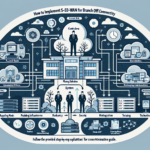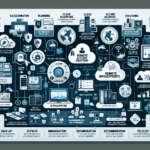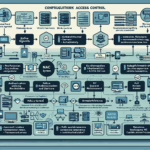Configuring IT infrastructure for Virtual Desktop Infrastructure (VDI) requires careful planning, selection of appropriate hardware and software, and a robust deployment strategy. Here’s a step-by-step guide to help you design and implement a VDI solution:
1. Assess Business Requirements
- Understand Use Cases: Determine why the organization needs VDI. Is it for remote work, secure access, or specialized workloads like engineering and design?
- Estimate User Load: Calculate the number of users, concurrency, and the type of workloads (general office, multimedia, 3D modeling, etc.).
- Performance Needs: Define user performance expectations, including latency, application responsiveness, and data access speeds.
2. Choose the Right VDI Solution
- VDI Platforms:
- VMware Horizon
- Citrix Virtual Apps and Desktops
- Microsoft Azure Virtual Desktop (AVD)
- Nutanix Frame
- Cloud-Based or On-Premises:
- Cloud VDI for scalability and remote access.
- On-premises VDI for compliance and control.
3. Design the IT Infrastructure
Compute (Servers)
- Select enterprise-grade servers with sufficient CPU, RAM, and GPU resources:
- CPU: Multi-core processors with high clock speeds (Intel Xeon or AMD EPYC).
- RAM: Allocate at least 4–8 GB per virtual desktop; reserve memory for the hypervisor and management.
- GPU: For graphics-intensive workloads (e.g., CAD, video editing), include NVIDIA GPUs with vGPU software like NVIDIA GRID.
Storage
- Performance: Use SSDs or NVMe for low latency and high IOPS.
- Capacity: Ensure sufficient storage for OS images, user profiles, and applications.
- Type:
- All-Flash Storage for high-performance workloads.
- Hybrid Storage (HDD+SSD) for cost efficiency.
- Storage Protocols: Use SAN, NAS, or hyper-converged infrastructure (HCI) depending on scalability needs.
Network
- Bandwidth: Ensure high-speed connections between end-users and the VDI infrastructure.
- Redundancy: Use redundant network paths to prevent downtime.
- Segmentation: Isolate VDI traffic using VLANs or SDN (Software-Defined Networking) for security.
- Load Balancing: Deploy load balancers to evenly distribute user sessions across VDI servers.
Backup and Recovery
- Backups: Integrate VDI-specific backup solutions to protect user profiles and desktop images.
- Disaster Recovery: Design a DR solution that replicates VDI workloads to a secondary site or cloud.
4. Implement Virtualization and Hypervisor
- Deploy a hypervisor to manage virtual machines (VMs) and optimize resource utilization.
- Examples: VMware ESXi, Microsoft Hyper-V, Nutanix AHV, or KVM.
- Enable features like resource allocation, clustering, and high availability (HA).
5. Configure VDI Components
Desktop Images
- Create and maintain a golden master image of the operating system with pre-installed applications.
- Use tools like VMware App Volumes or Citrix App Layering for application virtualization.
User Profile Management
- Implement profile management solutions like FSLogix or Citrix Profile Management to ensure seamless user experience across sessions.
Connection Broker
- Deploy a connection broker to manage user connections to virtual desktops.
- Examples: VMware Horizon Connection Server, Citrix Delivery Controller.
- Configure policies for session management, user authentication, and resource allocation.
Authentication
- Use multi-factor authentication (MFA) for secure logins.
- Integrate with Active Directory for centralized user management.
6. Optimize for Performance
- Patching and Updates: Regularly update the hypervisor, VDI software, and OS images.
- Resource Scaling: Monitor resource usage and scale compute, storage, or network as needed.
- Image Optimization: Optimize golden images by disabling unnecessary services and features.
7. Test and Pilot
- User Testing: Deploy a small-scale pilot to test performance, usability, and security.
- Load Testing: Simulate peak user loads to ensure stability and scalability.
- Fine-Tuning: Adjust configurations based on feedback and monitoring results.
8. Security and Compliance
- Endpoint Security: Secure client devices with antivirus and endpoint detection solutions.
- Encryption: Encrypt data-in-transit (using TLS) and data-at-rest.
- Access Control: Apply least privilege access and role-based permissions.
- Compliance: Ensure the solution meets industry standards (e.g., GDPR, HIPAA).
9. Monitoring and Management
- Use centralized monitoring tools to track system health, resource utilization, and user experience.
- Examples: VMware vRealize Operations, Citrix Director, or third-party monitoring tools.
- Automate routine tasks like patching, scaling, and backups.
10. Plan for Growth
- Scalability: Design the infrastructure to accommodate future growth in user numbers or workloads.
- Hybrid/Cloud Extension: Explore hybrid cloud options to extend capacity during peak demand.
Example Hardware Design for 500 Users
- Compute:
- 4 servers with dual Intel Xeon CPUs, 512 GB RAM, and NVIDIA A16 GPUs.
- Storage:
- 50 TB All-Flash SAN with NVMe capabilities.
- Network:
- 10 GbE switches with redundancy and VLANs for segmentation.
- Software:
- VMware Horizon or Citrix Virtual Apps and Desktops.
By following this structured approach, you can build a robust, scalable, and secure VDI infrastructure that meets your organization’s needs.
How do I configure IT infrastructure for virtual desktop infrastructure (VDI)?




